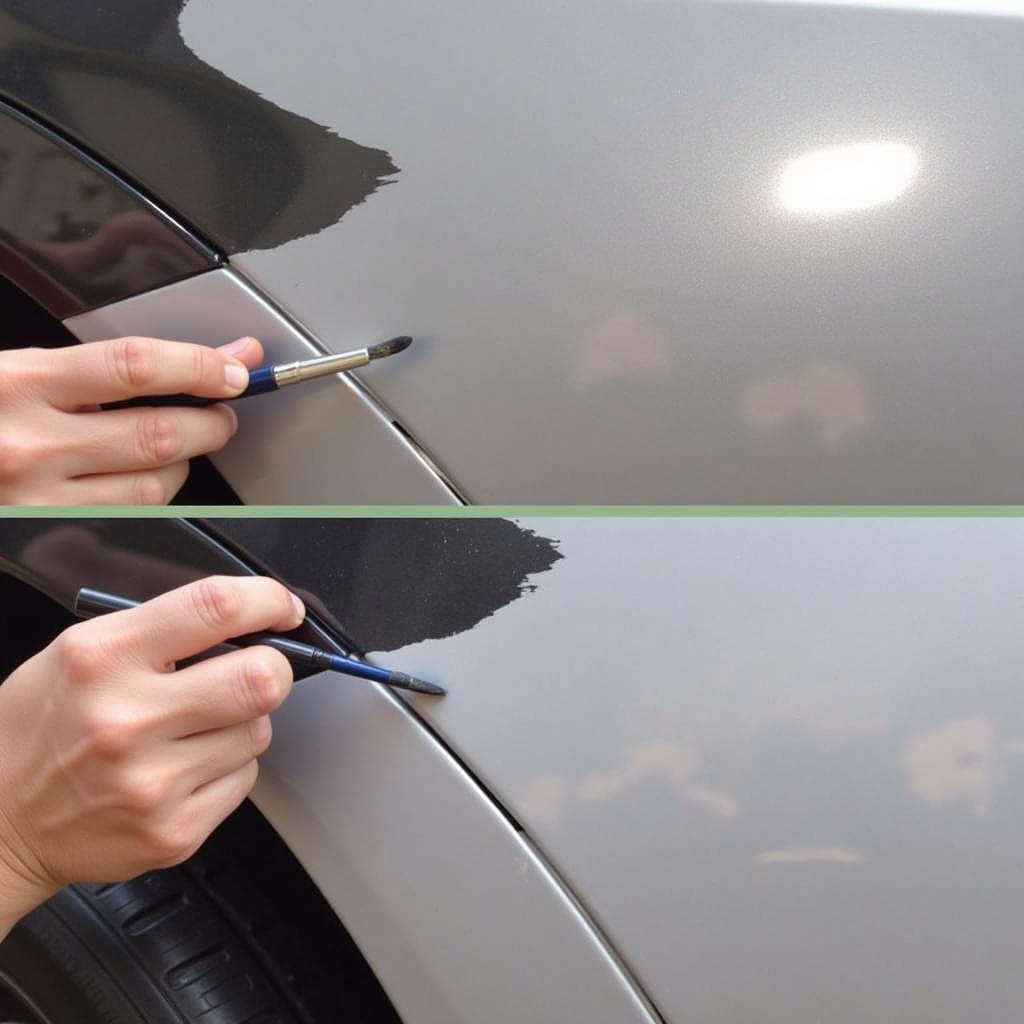Fixing car scrapes is a common issue for car owners. Whether it’s a minor scratch from a shopping cart or a deeper scrape from a parking mishap, understanding how to address these blemishes can save you money and keep your car looking its best. This guide provides a step-by-step approach to fixing car scrapes, from assessing the damage to achieving a professional-looking repair.
Assessing the Damage: Is it a Scratch or a Scrape?
Before you start fixing car scrapes, it’s crucial to determine the extent of the damage. A light scratch might only affect the clear coat, while a deeper scrape could penetrate the paint and even reach the primer or metal. Run your fingernail across the scrape. If your nail catches, it indicates a deeper scrape requiring more attention.
If the scrape is minor and only affects the clear coat, you might be able to fix it with a rubbing compound or a DIY scratch remover kit. how to fix bluetooth delay in car For deeper scrapes, you’ll need to use touch-up paint, primer, and clear coat. Ignoring deep scrapes can lead to rust and further damage, so prompt action is key.
DIY Fix for Minor Car Scrapes
For minor car scrapes affecting only the clear coat, a rubbing compound can work wonders. Wash and dry the affected area thoroughly. Apply a small amount of rubbing compound to a clean microfiber cloth and rub it onto the scrape using gentle, circular motions. Buff the area until the scratch disappears.
How to Apply Rubbing Compound
- Clean the area: Ensure the area is free from dirt and debris.
- Apply compound: Use a small amount of rubbing compound on a microfiber cloth.
- Rub gently: Use circular motions and light pressure.
- Buff the area: Continue rubbing until the scratch disappears.
- Wax the area: Apply wax to protect the repaired area.
how to fix a hot wired car Deeper scrapes require a more involved approach. You’ll need to clean the area, apply primer if necessary, then carefully apply touch-up paint to match your car’s color. After the paint dries, apply clear coat to seal and protect the repair.
Fixing Deeper Car Scrapes: A Step-by-Step Guide
- Clean the area: Thoroughly clean the scraped area with soap and water.
- Sand the area: Use fine-grit sandpaper to smooth the edges of the scrape.
- Apply primer (if needed): If the scrape has reached the metal, apply a thin coat of primer.
- Apply touch-up paint: Carefully apply touch-up paint to the scraped area, ensuring a smooth, even coat.
- Apply clear coat: Once the paint dries, apply clear coat to protect the repair.
“Proper preparation is crucial when fixing car scrapes,” advises John Smith, Automotive Repair Specialist at Smith Auto Repair. “Taking the time to clean and prepare the surface will significantly impact the final result.”
 Applying Touch-up Paint to Deep Car Scrape
Applying Touch-up Paint to Deep Car Scrape
can a hot wired car be fixed “Remember to choose the correct touch-up paint for your car’s color,” adds Maria Garcia, Lead Technician at Garcia Auto Body. “A slight mismatch can make the repair more noticeable.”
how to fix a car that has been hotwired Finally, after the clear coat dries, you can polish the area to blend the repair seamlessly with the surrounding paint. Fixing car scrapes effectively requires patience and attention to detail. Don’t rush the process, and always follow the product instructions carefully.
Conclusion: Keeping Your Car Looking Its Best
Fixing car scrapes is a manageable task that can significantly improve your car’s appearance. By following the steps outlined in this guide, you can address minor scratches and deeper scrapes effectively. Remember to assess the damage properly and use the appropriate techniques and products for the best results. Need help? Contact AutoTipPro at +1 (641) 206-8880 or visit our office at 500 N St Mary’s St, San Antonio, TX 78205, United States.
FAQ
- What’s the difference between a car scratch and a scrape? A scratch typically affects the clear coat, while a scrape is deeper and can penetrate the paint.
- Can I Fix Car Scrapes myself? Yes, you can fix minor scrapes yourself with a rubbing compound or touch-up paint kit. Deeper scrapes might require professional help.
- What type of sandpaper should I use for fixing car scrapes? Use fine-grit sandpaper (2000-grit or higher) to avoid further damage to the paint.
- How do I choose the right touch-up paint? Check your car’s owner’s manual or look for the paint code located on a sticker inside the driver’s side doorjamb.
- When should I seek professional help for fixing car scrapes? If the scrape is very deep, involves significant damage to the paint or metal, or you’re not comfortable tackling the repair yourself, it’s best to consult a professional.
- How can I prevent car scrapes? Park carefully, avoid tight parking spaces, and be mindful of shopping carts and other potential hazards.
- What should I do if the scrape is on a plastic bumper? Use a plastic bumper repair kit, which usually includes a filler and paint specifically designed for plastic surfaces.




Leave a Reply